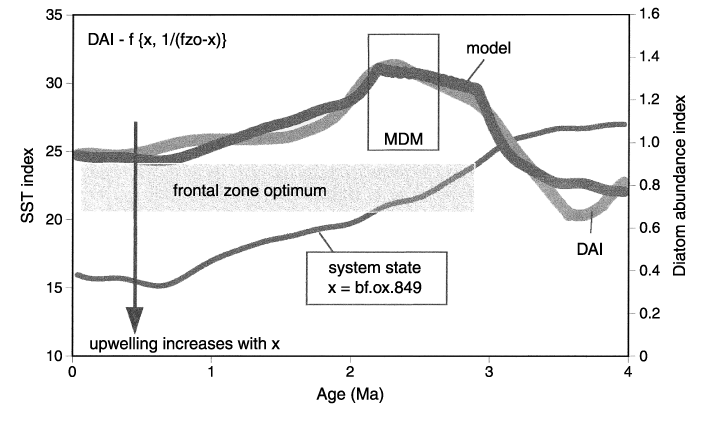Figure F32.
Conceptual model of the Matuyama Diatom Maximum (MDM) between 2.6 and 2.1 Ma. The input parameter is the system state x, represented by deepwater oxygen isotopes ( 18O of benthic foraminifers from Site 849, eastern equatorial Pacific; Mix et al., 1995), greatly smoothed. A frontal zone optimum is defined as those numbers of x that lie within the interval MDM. The model depends on x itself (taken as a proxy for upwelling) and on the absolute difference of x to the nearest value within the frontal zone optimum. All such difference values are increased by 0.5 and then inverted to write the two-dimensional equation (see
"Early Matuyama Diatom Maximum: Search for Mechanisms" in
"Lüderitz Site (Site 1084)"). The Site 1084 diatom abundance index (DAI) data are from Lange et al. (1999); the sea-surface temperature (SST) index (y-axis) is based on transforming x to the mean and range of the Site 1084 alkenone SST of Marlow et al. (2000).
18O of benthic foraminifers from Site 849, eastern equatorial Pacific; Mix et al., 1995), greatly smoothed. A frontal zone optimum is defined as those numbers of x that lie within the interval MDM. The model depends on x itself (taken as a proxy for upwelling) and on the absolute difference of x to the nearest value within the frontal zone optimum. All such difference values are increased by 0.5 and then inverted to write the two-dimensional equation (see
"Early Matuyama Diatom Maximum: Search for Mechanisms" in
"Lüderitz Site (Site 1084)"). The Site 1084 diatom abundance index (DAI) data are from Lange et al. (1999); the sea-surface temperature (SST) index (y-axis) is based on transforming x to the mean and range of the Site 1084 alkenone SST of Marlow et al. (2000).

![]()